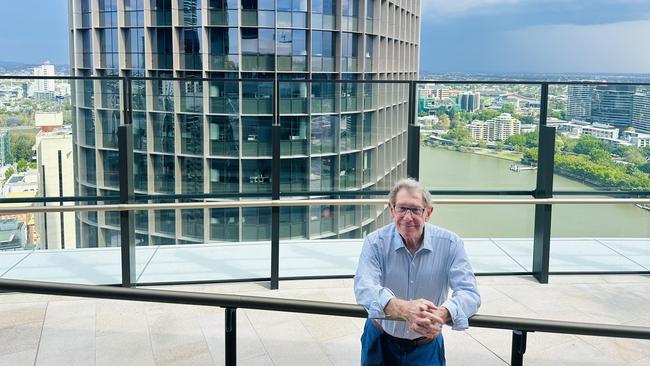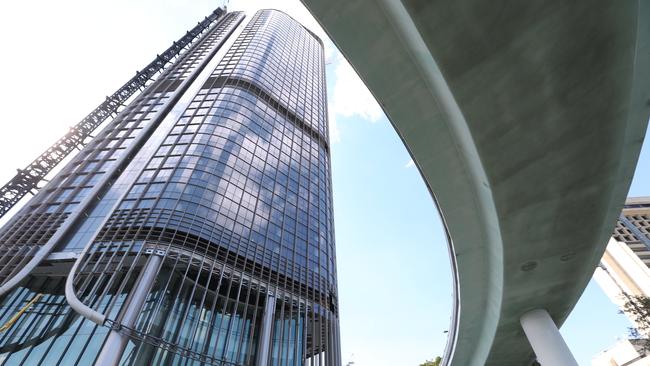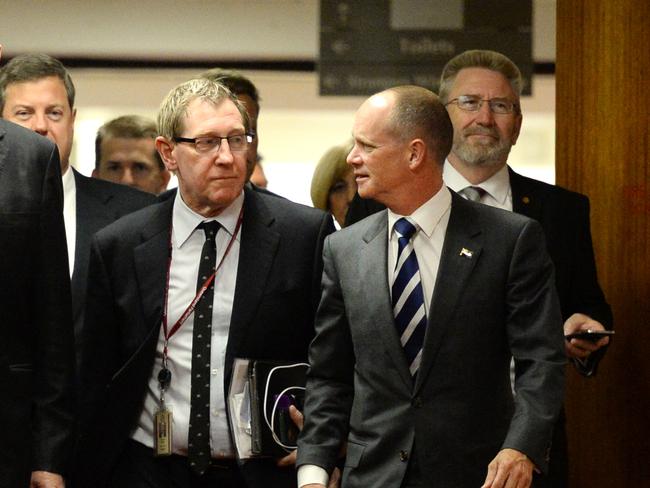Des Houghton: The visionary minister behind Brisbane’s modern skyline
The Palaszczuk Government may have seen the project through, but it was a forgotten LNP character, rejected by his own party, who was the driving force behind Brisbane’s modern new cityscape, writes Des Houghton.
Des Houghton
Don't miss out on the headlines from Des Houghton. Followed categories will be added to My News.
You can badmouth Campbell Newman if you must, but you only have to stroll through the imposing Queen’s Wharf precinct as I did this week to see what his government was capable of.
The Star hotel and casino is a gargantuan and exciting destination that will redefine Brisbane tourism for decades to come.
The footbridge to South Bank and the riverwalks are welcome additions to the public realm.
The precinct that includes the Tower of Power is a triumph of the Can-do Campbell LNP government.
As I step from the ferry at North Quay and stroll towards The Star, I wonder what more Newman could have achieved had his mission not been so abruptly curtailed.
While Newman was enthusiastic for Queen’s Wharf, the defining project was not his brainchild.
The credit for that must go to his Minister for Housing and Public Works, Dr Bruce Flegg, a forgotten hero of Queensland politics.
“When I came into the ministry this area was hopelessly under-utilised,” Flegg told me over coffee at the Sky Deck, 100m above the ground.
“The buildings like the Neville Bonner building and the Executive building were out of date and had to go.”
Flegg also signed the death warrant for the Department of Works and Housing building where he had his office. He wanted something “modern and exciting’’.

“My objective was to lift the vitality of the whole area,” he said.
First, he had to sell it to Newman.
Flegg invited him to his office and he turned up with Treasurer Tim Nicholls.
“I had a little plastic model made very early on in our first weeks in government,” Flegg said.
“They didn’t always agree with me on everything, but they immediately saw the logic of it.
“Campbell and Tim accepted, as I did, that to get the right parties interested in it and to attract the right amounts of money, it would have to have a casino licence, among other things.
“If you are going to get developers to come in and put their money into a multibillion-dollar project, a casino licence in an integrated resort is the only way. They understood that.
“I told them it had to stack up with retail, hotels and apartments, entertainment venues, a dining precinct and a casino as part of the plan.’’
Newman and Nicholls saw the big picture. Newman backed Flegg’s judgement.
“We started with One William Street (The Tower of Power) which was originally proposed to be a 40,000sq m ‘house’ for the public service,’’ Flegg said.
“The site itself was completely constrained by the freeway and on-ramps so there was no potential for public space or other use.
“So I ordered that to be changed from 40,000sq m to 60,000sq m.
“I put a line through 40,000 on the plan and wrote 60,000 and nobody every quizzed it.’’
The change allowed a taller building on a bigger footprint to allow more office space and therefore more savings for taxpayers.
“At the time we were leasing 200,000sq m of space in private buildings within the CBD, so I thought there was an opportunity to make significant savings.

“The executive building was also beyond its use-by date. It was a very inefficient building, and it had to go.
“We had the opportunity to demolish several outdated government buildings along this magnificent frontage to the Brisbane River which at that time was completely unused. There was no access or vision of the river.’’
Flegg’s plan was to knock down the Neville Bonner building and the Department of Works and Public Housing building and consolidate a block the size of 12 football fields.
“The Neville Bonner building had, from memory, one staff member for every 17sq m of floor space. I think the accepted standard was more like one staff member for every 6 sqm of floor space,’’ he said
Flegg was grateful Newman let him run with the project – at least while they both remained in office.
“It was 100 per cent my idea,” Flegg said. “To redevelop this site with access to the river was a bit of a no-brainer really. They were very poor-quality buildings.’’
Newman agreed the project would not proceed until the developers gave binding undertakings to protect heritage buildings in the precinct.
When the tide went out for the LNP, the Palaszczuk government finished the project. Along the way Flegg was falsely accused of wrongdoing and exonerated. He won $775,000 in damages in a defamation case. But the LNP did not endorse him for the next election.
Flegg joined me for lunch in the building. His first impressions were positive. So were mine. I thought the architecture verged on the epic without being too flamboyant. A vulgar little Las Vegas it is not.

Congratulations to The Star Entertainment Group for that and for pressing ahead in the face of cost overruns and interstate integrity shortcomings. The Star required a bankers’ bailout.
Was there ever a grand building from the Acropolis to the Sydney Opera House that did not have a traumatic birth?
Of course there are empty spaces and some scaffolding, but these enormous developments take years to settle in. In time there will be 12ha of landscaped riverside parklands, 1000 premium hotel rooms in four luxury hotels, 50 bars and restaurants, world-class entertainment, luxury retail and 1,500 residential apartments. Nine heritage buildings will be restored, and the developer has promised “stunning” public artworks. Not too stunning, I hope.
Flegg, meanwhile, has returned to medical practice and helps out as a locum at remote hospitals.
This year he was on duty at Normanton, Cloncurry, Baralaba, Miles, Augathella and Charleville.
And he has purchased 30 race horses now stabled in the Hunter Valley and Victoria. His aim is to win a Melbourne Cup.
“I’m serious,” he said.



